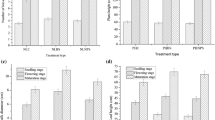Abstract
Atrazine and bifenthrin persistence study was carried out in three sludge amended soil under laboratory condition. Atrazine persisted shorter in sludge amended soil sludge-3 (half-life 23.4 days) followed by sludge-2 (half-life 30.1 days) and sludge-1 (half-life 37.1 days) than unamended control (half-life 150.5 days). Bifenthrin followed the similar pattern with sludge-3 (half-life 43.1 days) which increased to 50.3, 60.2 and 75.2 days, respectively in sludge-2, sludge-1 and unamended control representing an immense influence of sludges on degradation. Duncan’s Multiple Range Test revealed that carbon mineralization process was significantly influenced by all the sludges (p < 0.0001). Sludge-3 indicated highest Cmin (initial 118.16 to final 133.64 mg CO2–C/kg) in bifenthrin and 129.91 mg CO2–C/kg in atrazine. The relatively high Cmin rate in sludge amended soil than unamended control suggested a lower persistency of both the pesticides and thus decreasing its potential ecological risk. Sludge-3 sludge amended soil increased the dehydrogenase enzyme activity as compared to sludge-1 and sludge-2 sludge in atrazine.





Similar content being viewed by others
References
Ahmad T, Ahmad K, Ahad A, Alam M (2016) Characterization of water treatment sludge and its reuse as coagulant. J Environ Manage 182:606–611
Burnett G, Balu K, Barton H, Chen W, Gold B, Hertl P, Nelson D, Scott P, Winton K (2000) Summary of environmental fate of atrazine. Study No. 1213–99, Novartis Crop Protection, Inc., Greensboro, NC, USA
Casida LE, Klein D, Santoro T (1964) Soil dehydrogenase activity. Soil Sci 98:371–376
Das SK, Mukherjee I (2012) Effect of moisture and organic manure on persistence of flubendiamide in soil. Bull Environ Contam Toxicol 88:515–520
Das SK, Mukherjee I (2011) Effect of light and pH on persistence of flubendiamide. Bull Environ Contam Toxicol 87(3):292–296
Ferraro JR (1971) Low-frequency vibrations of inorganic and coordination compounds. Plenum Press, New York, USA
Joergensen RG (1996) The fumigation–extraction method to estimate soil microbial biomass: calibration of the kEC value. Soil Biol Biochem 28:25–31
Kumar N, Mukherjee I, Sarkar B, Paul RK (2017) Degradation of tricyclazole: effect of moisture, soil type, elevated carbon dioxide and blue green algae (BGA). J Hazard Mater 321:517–527
Maisnam J, Singh SB, Kulshrestha G, Arya S (2009) Persistence of alachlor in sandy loam soil. Ann Pl Protec Sci 17(2):456–458
Mukherjee I, Das SK, Kumar A (2012) A Fast, Inexpensive and safe method for residue analysis of flubendiamide in different vegetables by liquid chromatography/uv detector. Pesticide Res J 24:159–162
Mukherjee I, Das SK, Kumar A (2016) Degradation of flubendiamide as affected by elevated CO2, temperature, and carbon mineralization rate in soil. Environ Sci Pollut Res 23(19):19931–19939
Mukherjee I, Gopal M, Das TK (2007) Soil amendment: a technique for soil remediation of lactofen. Bull Environ Contam Toxicol 79:49–52
Popov VH, Cornish PS, Sultana K, Morris EC (2005) Atrazine degradation in soils: the role of microbial communities, atrazine application history, and soil carbon. Aust J Soil Res 43(7):861
Sharma D, Singh SB (2012) Persistence of bifenthrin in sandy loam soil as affected by microbial community. Bull Environ Contam Toxicol 88(6):906–908
Stone WW, Gilliom RJ, Ryberg KR (2014) Pesticides in U.S. streams and rivers: occurrence and trends during 1992–2011. Environ Sci Technol 48:11025–11030
Suman A, Ahmed K, Haq I (2018) Water treatment plant sludge characterization, recovery of coagulant and its reuse. Int J Res Eng Tech 7(7):214–220
Sluszny C, Graber E, Gerstl Z (1999) Sorption of s-triazine herbicides in organic matter amendment soils: fresh and incubated systems. Water Air Soil Pollut 115:395–410
Toccalino PL, Hopple JA. (2010). The quality of our Nation’s waters-quality of water from public supply wells in the United States, 1993–2007-Overview of major findings. U.S. Geological Survey Circular 1346: 58p.
Van der Maas JH (1972) Basic Infrared Spectroscopy, 2nd edn. Heyden & Son Ltd., London, UK
Vance ED, Brookes PC, Jenkinson DS (1987) An extraction method for measuring soil microbial biomass. Soil Biol Biochem 19:703–707
Vryzas Z, Alexoudis C, Vassiliou G, Galanis K, Papadopoulou-Mourkidou E (2011) Determination and aquatic risk assessment of pesticide residues in riparian drainage canals in northeastern greece. Ecotoxicol Environ Safety 74(2):174–178
Wang H, Xu J, Scott RY, Zhang J, Gan J, Mac J, Wu J, Xuan R (2010) Mineralization of metsulfuron-methyl in Chinese paddy soils. Chemosphere 78:335–341
Zibilski LM. (1994). Carbon mineralization. In: Bingham JM, Mickelson SH (eds) Methods of soil analysis, Part 2, Microbiological and biochemical properties. SSSA, Book Series No. 5. ASA, SSSA, Madison
Author information
Authors and Affiliations
Corresponding author
Additional information
Publisher's Note
Springer Nature remains neutral with regard to jurisdictional claims in published maps and institutional affiliations.
Rights and permissions
About this article
Cite this article
Mukherjee, I., Das, S.K., Kumar, A. et al. Sludge Amendment Affect the Persistence, Carbon Mineralization and Enzyme Activity of Atrazine and Bifenthrin. Bull Environ Contam Toxicol 105, 291–298 (2020). https://doi.org/10.1007/s00128-020-02917-7
Received:
Accepted:
Published:
Issue Date:
DOI: https://doi.org/10.1007/s00128-020-02917-7




